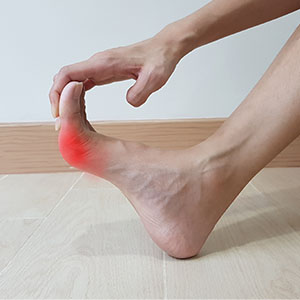Bunions are a common medical ailment, with roughly 20% of adults expected to experience this issue annually. Bunions are caused by an improper alignment of joints, ligaments, and bones within the foot and most commonly form due to factors such as wearing uncomfortable or improperly fitting footwear, sports injuries, the natural shape of one’s foot, and more. Although bunions are extremely common, it doesn’t make them any less painful, irritating, or difficult to treat on your own. Treating bunions can be daunting, but doing so is the key to relieving pain and preventing the risk of further medical complications or related ailments in the future. While there is a wide array of products on the market designed to help people suffering from bunions at home, few –– if any –– can actually offer long-term, meaningful solutions to the problem that is suffering from bunion pain.
If you’re suffering from the excruciating pain and overwhelming discomfort typically associated with bunions, it is crucial to seek treatment right away to feel better as soon as possible and to eliminate the risk of further medical complications from developing in the future. With so many treatment options available on the market, it can be difficult. Today, we will focus on one of the more popular pain-relief products on the market –– the bunion sleeve. Here, we will explain how it works and what it does, and answer the most critical question of all: “do bunion sleeves work?”
What Are Bunions?
Bunions are a painful condition that often occurs as a result of imbalanced pressure causing the misalignment of one’s foot, causing the big toe to curve inward. A number of genetic and environmental factors can cause bunions.
Inherited foot structure abnormalities, such as flat feet or low arches, can contribute to the development of bunions. Additionally, wearing uncomfortable or ill-fitting shoes, such as those with narrow-toe boxes and high heels, can cause or worsen the condition. The pressure and friction from footwear can force the big toe to deviate toward the smaller toes, leading to the misalignment of the joint and the formation of a bunion.
There are many products on the market that are intended to treat this condition at home and without the help of a medical professional; unfortunately, these tools do not work as a long-term treatment for pain. The bunion sleeve is one of the most common over-the-counter products used to treat bunion pain at home.
What Does a Bunion Sleeve Do?
Before we can answer questions like, “do bunion sleeves work,” it is essential to define a bunion sleeve.
A bunion sleeve is essentially a larger version of a bunion pad or cushion. It is not to be confused with a bunion splint, a special device that separates the toes and stretches the tendons and ligaments in the foot. Bunion splints can prove effective in a particular situation; however, they do not work independently to treat the bunion pain, despite what some people might believe.
Bunion sleeves, unlike splints, act more or less to cut down on friction caused by a bunion rubbing up against the interior surface of a shoe. In this way, bunion sleeves may reduce some pain an individual feels when walking around with a bunion. When combined with comfortable footwear, a bunion sleeve may afford an individual mild relief from bunion pain on a short-term basis.
Do Bunion Sleeves Cure Bunions?
So, do bunion sleeves work to cure bunions effectively? The short answer to this question is no; bunion sleeves are not designed to cure bunions. Bunions are caused by an improper alignment of joints, ligaments, and bones within the foot. And though bunion sleeves may offer some pain relief, they will not help to restore balance to the foot, reduce the bunion, or remove it. The bad news here is that bunions tend only to worsen over time –– whether an individual uses bunion pads, sleeves, or cushions.
While it may seem tempting to try to treat bunion pain at home using a corrective device such as a bunion sleeve, cushion, or pad, the unfortunate truth is that these tools do not work as a long-term solution to bunions as they do not treat bunions at their source.
Addressing Bunion Pain for Good
The only way to get rid of bunion pain is to have it removed through a surgical procedure. Understandably, some individuals may feel anxious about undergoing surgery to remove a bunion, as bunion removal surgery has long been considered to be one of the most painful procedures a patient can undergo. While bunion surgery has earned a bad reputation for being painful and coming along with an extensive, restrictive recovery period, the good news is that modern minimally invasive bunion surgery is completely safe, effective, and painless and serves as an alternative for patients who want to remove a bunion for good without undergoing a painful or difficult procedure.
So, how does it work? At Northwest Surgery, we make procedures like minimally invasive bunion removal surgeries easy.
During a minimally invasive bunionectomy, a surgeon will make a very small incision along the side of the foot to remove the bunion and realign the foot to its proper orientation. Thanks to innovations in this field, modern bunion surgery is both very convenient and patient-friendly.
Certain key features and benefits of minimally invasive bunion surgery as performed at NWSC include:
Short procedure time. This outpatient procedure typically lasts between 90 minutes and 2 hours, including pre-operative preparation and post-operative care.
Quick recovery. Most patients are able to drive home and resume their normal daily routine with few interruptions after the procedure.
Minimal scarring. Small incisions protect the foot from unsightly scar tissue forming.
Effective bunion removal- the results of minimally invasive bunion surgery are long-lasting since the procedure treats bunions at the cause.
If you are looking for a fast, safe, and highly effective method for treating bunions once and for all, minimally invasive surgery is a great option. The minimally invasive bunionectomy is virtually painless and requires little to no restrictive recovery time, making it easy to undergo treatment without disrupting your normal life and regular routines.
Minimally Invasive Bunion Surgery at NWSC
If you are suffering from bunion pain, don’t wait to seek treatment. Leaving bunions untreated for an extended period of time can increase your risk of developing further medical conditions such as hammertoes, heel spurs, and more, which will require further treatment. Here at Northwest Surgery Center, our team uses the most advanced methods and sophisticated tools available to ensure positive outcomes for all of our patients. We specialize in treating foot pain issues and can help you address problems like bunions, corns, hammertoes, and heel spurs. Thanks to our innovative minimally invasive surgical procedures, treating these common orthopedic conditions and finding permanent relief from pain has never been easier!
Don’t wait to treat your bunions; let the minimally invasive surgery experts at Northwest Surgery Center put an end to your pain once and for all. Contact us here for more information about the treatments and services we offer or to schedule a free consultation with a member of our team.



Leave A Comment